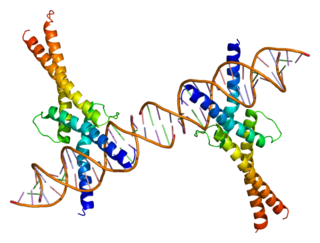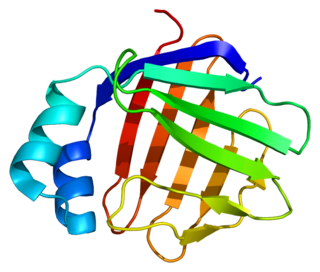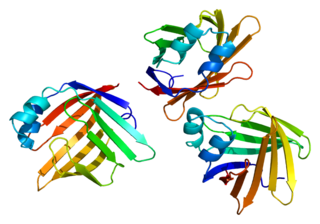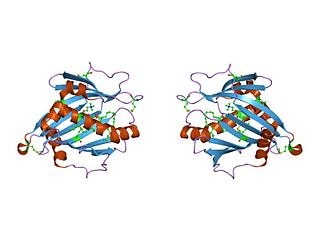
aP2 is a carrier protein for fatty acids that is primarily expressed in adipocytes and macrophages. aP2 is also called fatty acid binding protein 4 (FABP4). Blocking this protein either through genetic engineering or drugs has the possibility of treating heart disease and the metabolic syndrome.

Hormone-sensitive lipase, also previously known as cholesteryl ester hydrolase (CEH), sometimes referred to as triacylglycerol lipase, is an enzyme that, in humans, is encoded by the LIPE gene.

Sterol regulatory element-binding transcription factor 1 (SREBF1) also known as sterol regulatory element-binding protein 1 (SREBP-1) is a protein that in humans is encoded by the SREBF1 gene.

N-Arachidonyl glycine receptor, also known as G protein-coupled receptor 18 (GPR18), is a protein that in humans is encoded by the GPR18 gene. Along with the other previously "orphan" receptors GPR55 and GPR119, GPR18 has been found to be a receptor for endogenous lipid neurotransmitters, several of which also bind to cannabinoid receptors. It has been found to be involved in the regulation of intraocular pressure.

Free fatty acid receptor 3 (FFA3) is a G-protein coupled receptor that in humans is encoded by the FFAR3 gene.

G-protein coupled receptor 120 is a protein that in humans is encoded by the GPR120 gene.

Lysophosphatidic acid receptor 3 also known as LPA3 is a protein that in humans is encoded by the LPAR3 gene. LPA3 is a G protein-coupled receptor that binds the lipid signaling molecule lysophosphatidic acid (LPA).

DNA-binding protein inhibitor ID-3 is a protein that in humans is encoded by the ID3 gene.

FABP1 is a human gene coding for the protein product FABP1. It is also frequently known as liver-type fatty acid-binding protein (LFABP).

Adipose differentiation-related protein, also known as perilipin 2, ADRP or adipophilin, is a protein which belongs from PAT family of cytoplasmic lipid droplet(CLD) binding protein. In humans it is encoded by the ADFP gene. This protein surrounds the lipid droplet along with phospholipids and are involved in assisting the storage of neutral lipids within the lipid droplets.

Fatty acid binding protein 7, brain, is a human gene.

Fatty acid binding protein 6, ileal (gastrotropin), also known as FABP6, is a protein which in humans is encoded by the FABP6 gene.

Myelin P2 protein is a protein that in humans is encoded by the PMP2 gene. Myelin protein P2 is a constituent of peripheral nervous system (PNS) myelin, also present in small amounts in central nervous system (CNS) myelin. As a structural protein, P2 is thought to stabilize the myelin membranes, and may play a role in lipid transport in Schwann cells. Structurally, P2 belongs to the family of cytoplasmic fatty acid-binding proteins (FABPs).

Very long-chain acyl-CoA synthetase is an enzyme that in humans is encoded by the SLC27A2 gene.

Carbohydrate-responsive element-binding protein (ChREBP) also known as MLX-interacting protein-like (MLXIPL) is a protein that in humans is encoded by the MLXIPL gene. The protein name derives from the protein's interaction with carbohydrate response element sequences of DNA.

Oxysterol-binding protein-related protein 2 is a protein that in humans is encoded by the OSBPL2 gene.

Long-chain fatty acid transport protein 1 (FATP1) is a protein that in humans is encoded by the SLC27A1 gene.

Long-chain fatty acid transport protein 3 is a protein that in humans is encoded by the SLC27A3 gene.

Phosphatidylcholine transfer protein (PCTP) also known as StAR-related lipid transfer domain protein 2 (STARD2) is a specific intracellular phospholipid binding protein that can transfer phosphatidylcholine between different membranes in the cytosol.

Fas associated factor family member 2 is a protein that in humans is encoded by the FAF2 gene.



















